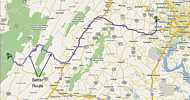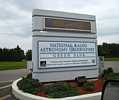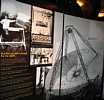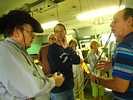Washington DC Trip
2009
External links:
- A novice-frendly introduction to radio telescopes
- Green Bank on NRAO web site
- Green Bank as on ESO "80 Telescopes" in 2009
- - - (try to sleep through the 2 minute lead in music) - Active Surface Architectures of Large Radio Telescopes Parker and Payne
- Holographic Measurement and Improvement of the Green Bank Telescope Surface Jul 2011, T. Hunter, et al
Green Bank Radio Telescope
1 Day Tour, September 24, 2009Entrance W - 79.8162008, N 38.430809
I *really* wanted to see the largest fully steerable single aperture radio telescope in the world.
National Radio Astronomy Observatory
which is in a 13,000 square mile "radio quiet" zone at Green Bank, WV.
(I'm a bit of a radio telescope junkie
|
| 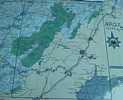
|
A goal was to also take the High Tech tour, offered the 4th Thursdays of the month.
| A telephoto from the visitor's center :-))) |
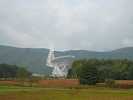
|
We were very early for the 3:30 PM High Tech tour, so had plenty of time to:
My e-mail contact, Cara Rose, was at the front desk. We had e-mailed each other so much it was like a high school reunion ;-))
There was intended to be a laser range finding system to help do a closed loop control
of the large reflecting surface. The low-tech guide says this system is now stalled for
undisclosed reasons. The surface is now under open loop control, errors are hard and slow to detect. Some of the early dreams for laser aided closed loop control are at:
Radio waves from external to our solar system were 1st detected, confirmed and published by Karl Guthe Jansky in 1933 while employed by
Bell Telephone Labs. The young radio engineer and amateur astronomer
Grote Reber got excited and
made a 9 meter parabolic antenna and eventually made the first radio map of the sky.
The "reconstructed" version is about 80 meters from the museum. The original components,
including the dish and elevation drive, are painted white, the rotational parts at the base, added later by NASA are painted red.
A major display in the museum
"In between Karl Jansky's discovery of cosmic radio waves and the end
of World War II, one man advanced the science of Radio Astronomy.
"That man was Grote Reber.
"Grote Reber was a young radio engineer and an accomplished Amateur Radio
Operator in Wheaton, Illinois when news of Jansky's discovery reached him. Reber
had built a short wave transmitter-receiver when he was fifteen and had "worked all
hobby. continents." By 1937, he felt that "there were no new worlds to conquer" in his hobby.
"In 1931 Karl Jansky discovered radio waves, or "cosmic static,"
coming from the Milky Way. Reber was enchanted by Jansky's discovery and foresaw the prospect
of putting his radio hobby to exciting new use.
"Reber contacted Jansky, offering to work for him, only to learn that Bell Labs had transferred
him to other projects.
Reber contacted leading astronomy observatories,
but could not interest them in radio astronomy , Like the "Little Red Hen," he thought to
himself: "Grote, old boy, if anyone is going to do it, it will have to be you."
"And so he did it. In his backyard, and at his own expense, he built the world's first
radio telescope. Its diameter, 31.4 feet, was dictated by the lumber available
at the local lumber store."
Across the museum isle, Reber's home made receivers.
We head back to Harrisonburg, VA, the way suggested by Cara - it is much better :-))
During the rest of the week, we toured
They have a fun museum and science display.
There are about 2,000 mechanical actuators to move corners of the "radio mirror" in and out
to help correct for the gravitational sag of the steel structure of the telescope as it tips
through various angles. This exhibit gives an idea of the operation of the system.

2 of me

1 of me

0 of me
and more recently
More on Grote Reber started Jan 2012
"Grote Reber - Grassroots Beginnings of a New Science

"...I was too young to know it wasn't possible."
As a point of reference,
at that time 20 meters (15 megahertz) was regarded as high frequencies by
most radio amateurs.
This may be the  tuned circuit
used to help generate signals to help develop the 160 MHz receiver above.
tuned circuit
used to help generate signals to help develop the 160 MHz receiver above.
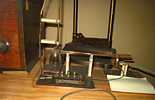

"Second Generation Receiver, center frequency 480 MHz, circa 1945" - about 0.62 meter wavelength.

- Wikipedia
- Reber researches in Tasmania
"Low Tech ;-))" Tour time
We pass the R&D building. We will be in here for the High Tech tour later this afternoon.
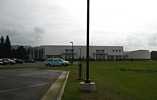
This is the last stop before:
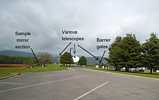
Oddly, this display is in the highly protected radio free zone. It is a real full scale model of
4 segments the mirror.
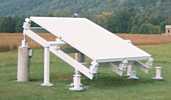
Another view. There are about 2,000 segments in the real mirror.
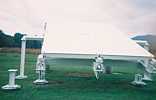
An actuator
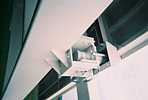
It turns out this is a maintenance day - later some ?painters? started rappelling down
from the right side of the dish. The guide says that it takes 6 minutes for the massive
assembly to turn 1/2 circle. This
explains the benefit of the more expensive offset design. (Executive summary: reduced defraction
due to no metal supports in the RF path gives much lower system noise level.) We are standing at
W -79.838459, N 38.432032

This is a giant machine - some say the largest, heaviest movable land object.
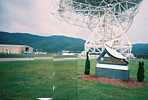
"High Tech :-))" Tour time
We are met at the Visitor's Center by a Receiver Engineer - The big deal is to
make/obtain stable ultra low noise receivers. This guy must be in the heat of the battle.
This is our High Tech tour guide, taking us by someone else's lower frequency receiver.
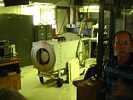
And this is where the operator sits, controlling that million pounds of steel a mile away.
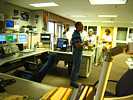
and probably won't leave home again for a year !! ;-))
